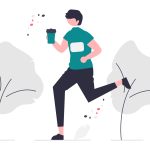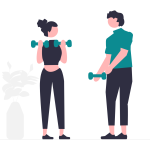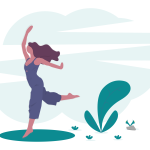10.6 Types of Physical Exercise
Cardiovascular (Aerobic) Training
Often referred to as “cardio,” this involves any planned activities that raise your heart rate and breathing while engaging large muscle groups. Activities like rowing, running, swimming, cycling, and even brisk walking all fall under this category.
Key Benefits
 |
|
Heart Rate Zones
Heart rate zones tell you how hard you’re working based on your heartbeats per minute (bpm). To use them, you first estimate your maximum heart rate (MHR) by using “220 minus your age.” If you’re 25, then 220 – 25 = 195 bpm.
Then, each heart rate zone is a certain percentage of that maximum. Using the example, training at 70% of your MHR would mean the heart rate goes no higher than 137 (195 x 0.7 = 137).
“Zone 2” Training
- Heart Rate Range: 60-75% of MHR
- What it is: Steady pace
- How It Feels: A steady pace where your heart is working harder than normal, but you can still speak in short sentences.
- Why It’s Important:
- Builds an “aerobic base,” helping your heart and lungs get better at using oxygen.
- Teaches your body to use fat for energy, preserving stored carbohydrates (glycogen) for tougher efforts later.
- Boosting mitochondrial efficiency (how cells produce energy) and lactate clearance (how your body handles fatigue).
- How Often: Endurance athletes may spend up to 75% of their training here to build stamina. Regular people can also make substantial and consistent improvements to their fitness with 2–4 30-minute sessions a week without burning out.
- Sample Workouts
- Brisk walking outside for 30 minutes
- Swimming for 15 minutes
- Biking for 60 minutes
“Zone 5” Training
- Heart Rate Range: >85% of MHR
- What It Is: Short bursts of very hard effort, like sprinting, followed by rest or easy movement. Sometimes called High-Intensity Interval Training (HIIT).
- How it Feels: Very, very intense. Can barely get words out. Heavy breathing.
Why It’s Important:- VO₂ Max: This measures how well your heart and lungs deliver oxygen to your muscles. A higher VO₂ max usually means better overall fitness and lower risk of chronic disease.
- Pushing near your limit improves heart efficiency and teaches muscles to use energy more effectively.
- How Often: One or two workouts per week can give big improvements. Doing more might cause exhaustion or injury if you don’t recover well.
- Sample Workouts
- 4×4: Go “all out” for 4 minutes. Recover with a much easier exercise for 4 minutes. Repeat 4 times (up to 6 if you’re feeling strong).
- Tabatta: 20 seconds of exercising as hard as you can, followed by 10 seconds of rest. Repeat 8 times.
- EMOM (Every minute on the minute): Perform a specific exercise or set of repetitions at the start of each minute. Whatever time is left in that minute after completion is your rest. When the next minute starts, you repeat the movement or move to a new one.
Resistance Training
Any exercise where you push or pull against some form of resistance. This may include free weights, machines, resistance bands, or even your own body weight. The main goal is to build muscle strength, size, and endurance.
Key Benefits
 |
|
Repetitions and Sets
This type of training involves performing a combination of sets and repetitions of an exercise. A repetition (or rep) is one complete movement of an exercise (e.g., one squat or one push-up). A set is a group of reps done without a rest. For example, three sets of 10 reps means you do 10 squats, rest, then do 10 more, rest, and do 10 more. But 10 sets of 3 reps means you do three squats, rest, and then repeat this nine more times.
Repetition Ranges
Depending on your goals, you may want to tailor your repetition ranges:
| Item | Low Reps (1 to 5 per set) | Medium Reps (6 to 12 per set) | High Reps (12+ per set) |
|---|---|---|---|
| Focus | Maximum strength and power | Muscle size (hypertrophy) | Muscular endurance |
| Example | Lifting heavier weights for fewer reps (like three sets of 5 deadlifts) | 3 sets of 8 to 10 squats or bench presses | 2 sets of 15 or more push-ups or resistance band exercises |
| Benefit | Builds raw strength and trains your nervous system to recruit more muscle fibers quickly | Ideal for adding muscle mass and improving overall body composition. | Helps your muscles keep going longer. Useful for sports, daily activities, and stamina. |
Mobility, Balance & Stability
These three elements are all about how well your body can move through its full range of motion while staying controlled and injury-free.
Key Benefits
 |
|
How to Train
Mobility Work
- Definition: Exercises that focus on flexibility and joint range of motion (e.g., dynamic stretches, foam rolling, gentle yoga flows).
- Why It Helps: Ensures your muscles and joints move freely, letting you perform activities with less stiffness and better technique.
Balance Training
- Definition: Exercises that challenge your body’s stability, like standing on one foot, using a balance board, or practicing single-leg squats.
- Why It Helps: Makes everyday tasks (like walking on uneven ground) safer and boosts athletic performance in sports that require quick direction changes.
Stability Drills
- Definition: Movements that strengthen your core and stabilizing muscles (e.g., planks, bird dogs, or stability ball exercises).
- Why It Helps: A strong “center” of the body supports better posture and protects against injuries by keeping joints in proper alignment.
Other Factors to Consider
When you are working on strength, endurance, and overall fitness, there are a few extra things that can make or break your long-term success:
Recovery
Why It Matters: Your body needs time to rebuild muscle, restore energy, and adapt after workouts.
Risks of Skipping: Overtraining can lead to injuries, burnout, and stalled progress.
How to Do It:
- Take rest days.
- Get quality sleep.
- Eat well, especially enough protein to help rebuild and repair muscle.
- Use active recovery methods like light cardio, gentle stretching, or yoga to reduce soreness.
Tracking Progress
What to Track:
- Strength Gains: Are you lifting heavier weights over time?
- Endurance: Can you run, swim, or cycle faster or farther?
- Body Composition: Are you gaining muscle or reducing body fat?
Why It Helps: Monitoring these factors keeps you motivated and shows where you need to adjust your training to reach your goals.
Identifying Barriers
Common Challenges:
- Busy schedules
- Limited access to a gym.
- Lack of motivation
- Persistent injuries.
- Mental roadblocks like self-doubt or depression.
Overcoming Them:
- Do things you like doing. This cannot be overstated. Don’t waste your time running if you hate running. Eventually, you will probably stop or hurt yourself. Less chance of quitting.
- Manage time more effectively (e.g., schedule shorter, efficient workouts).
- Set realistic goals you can actually stick to.
- Adapt workouts if you’re injured (e.g., switch to low-impact exercises).
- Focus on discipline over motivation—being comfortable with discomfort leads to lasting consistency.

Fanshawe College Fitness Centre
Want to know your body composition?
- Check out the Fanshawe College Fitness Centre and book a free InBody scan! It gives you a snapshot of your body fat and muscle percentage!

